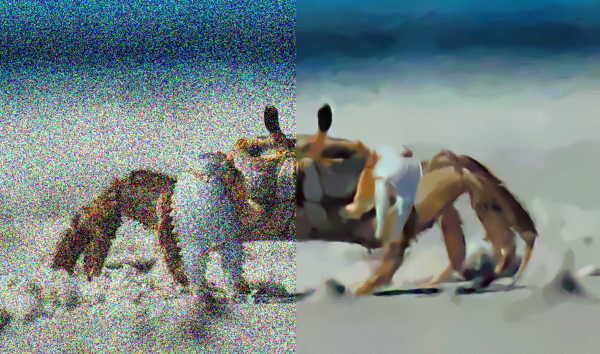Dr Graham Treece, Department of Engineering

The software can be used to apply RMAR [1] to DICOM sequences, and as a way of investigating the effects of these new filters on images.

The locally adaptive Bitonic X filter [4] has recently been assessed on images with traditional additive noise, and mobile phone images with real sensor noise.
The full online documentation (also available within the help for the software) is here:
The following details the updates for each software version:
The software can be downloaded using the following links:
wxDicom
wxDicom was originally written as a simple tool to demonstrate various image interpolation and filtering techniques in a teaching setting. It has since been expanded to allow it to load medical data from various sources (including DICOM) in addition to several standard image formats. It now implements several new filtering techniques developed by the author:- Refined Metal Artefact Removal (RMAR) for cleaning up DICOM data containing metal artefacts [1].
- The Bitonic Filter: a new noise reduction filter based on a mixture of morphological and linear operations [2].
- The structurally varying version of the Bitonic Filter, which offers significantly improved performance [3].
- The locally adaptive Bitonic X Filter, which is a new, highly competitive, far better performing, filter [4].


- G. Treece. Refinement of clinical X-ray computed tomography (CT) scans containing metal implants. Computerized Medical Imaging and Graphics, Vol. 56, pp. 11-23, March 2017.
- G. M. Treece. The bitonic filter: linear filtering in an edge-preserving morphological framework. IEEE Transactions on Image Processing, Vol. 25, No. 11, pp. 5199-5211, November 2016.
- G. M. Treece. Morphology-based Noise Reduction: Structural Variation and Thresholding in the Bitonic Filter. IEEE Transactions on Image Processing, Vol. 29, pp. 336-350, 2020.
- G. M. Treece. Real image denoising with a locally-adaptive bitonic filter. Technical report ENG-TR.006, Cambridge University Department of Engineering, September 2021.
- Graham Treece
- Introduction
- Teaching
- Research
- Publications
- Software
- Videos
- Personal
- Medical Imaging Group
- Overview
- Members
- Projects
- Research Opportunities
- Free Software
- Machine Intelligence Homepage
